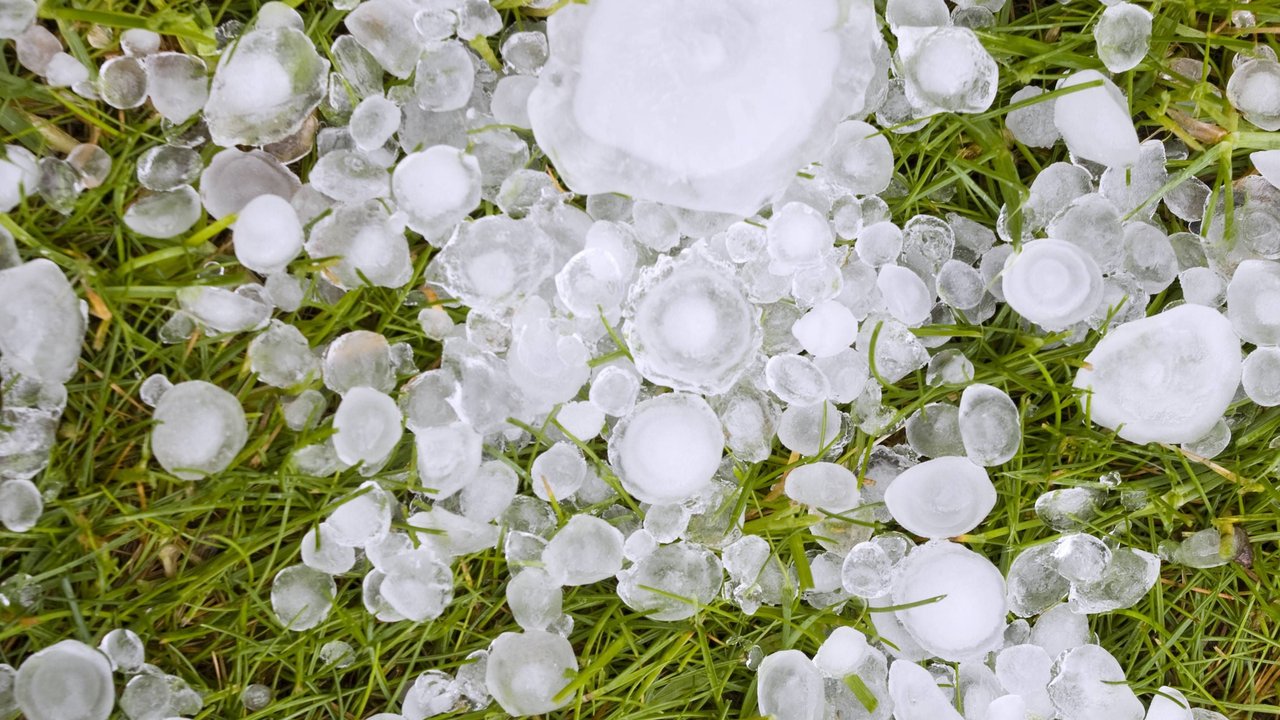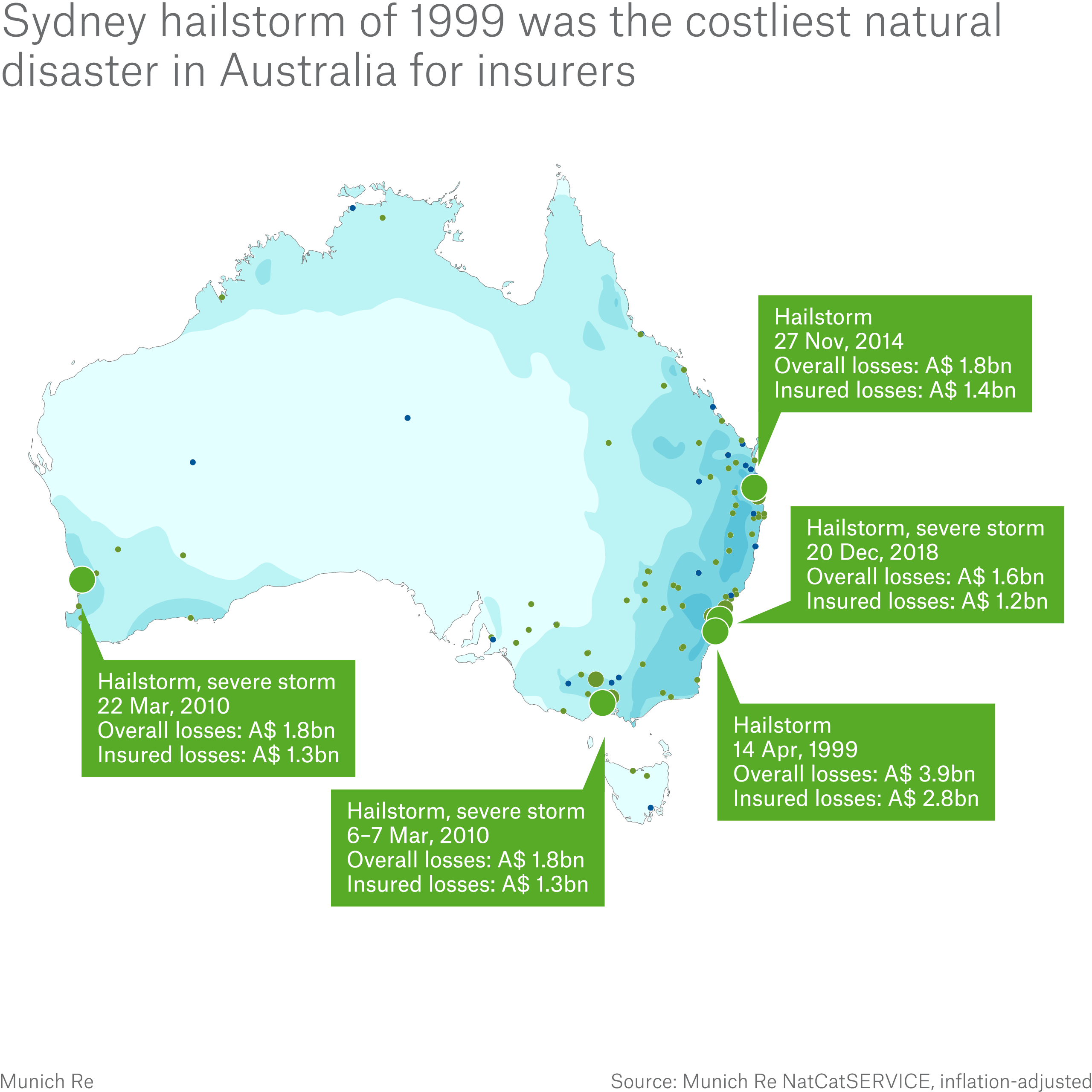
Over the last 39 years, accumulated losses (all in Australian CPI-adjusted values for 2018) from severe convective storms amount to around A$ 20.5bn for insured losses and A$ 33.6bn for direct economic losses. Compared to other perils in Australia, only losses from flood events attain similar proportions. In terms of frequency, losses from severe convective storms account for around 50% of all loss-producing natural hazard events occuring in Australia.
The costliest insured loss event in Australia to date (after adjusting for inflation) was the Sydney hailstorm of 1999. In the early evening of 14 April − untypically late in the season − a supercell storm had developed south of Sydney in the area around Kiama. It moved northwards, parallel to the coastline, via Wollongong, across Botany Bay, straight to central Sydney and further north to Palm Beach, up as far as Gosford over a distance of more than 200 km. The storm produced hailstones the size of cricket balls (7 cm), reaching its maximum intensity around the eastern suburbs of Sydney.
On its path, it caused damage to more than 45,000 houses, 63,000 cars, 23 planes and countless boats, resulting in more than 120,000 insurance claims. The total amount of insured losses reached A$ 1.7bn, and the estimated direct economic losses stood at ver A$ 2.3bn at the time. Adjusted for inflation, those values today would be equivalent to A$ 3.1bn and A$ 4.2bn respectively. Accounting for the increase in wealth and assets since 1999 (using local GDP growth as a proxy), the values could reach as much as A$ 5.1bn and A$ 7bn.

Brisbane hailstorm of 2014 produced the largest hailstones
In November 2014, a rather short-lived and localised but intense hailstorm battered the Brisbane area. The supercell produced hailstones even larger than those in 1999, and hit central parts of Brisbane during rush hour, causing damage to some 60,000 cars. The roofs, windows and claddings of more than 22,000 homes and commercial buildings were damaged, and about 30 people were injured. The number of insurance claims exceeded 100,000, with a total insured loss of A$ 1.5bn, and a direct economic loss estimated at A$ 1.9bn.
The Brisbane area is hit by hailstorms quite frequently. The most severe event affecting Brisbane prior to 2014 occurred in 1985. It caused insured losses of A$ 180m and about A$ 360m in direct economic losses, which is A$ 570m and A$ 1.2bn in CPI-adjusted values.
Two other recent prominent convective storm events with large hailstones and significant flash floods occurred in March 2010, affecting Melbourne and Perth, and one in December 2018 in Sydney. Each event generated insured losses of between A$ 1.3bn and 1.4bn, with the Perth event becoming the most expensive natural disaster in Western Australia.
Sydney hailstorm of 1999 was the costliest natural disaster in australia for insurers
Most of the losses from severe convective storms in Australia arise from hail and flash floods. Large hailstones cause damage to the roofing, windows and cladding of buildings, as well as hull damage to automobiles, trains, planes and boats. Once a roof is damaged, the accompanying rain can cause substantial damage to the interior and contents of the damaged property. Small hailstones can be harmful to certain crops, especially during the growing stage of the agricultural cycle. Flash floods inundate cars (which usually involves a total loss of the vehicle), as well as flooding basements and ground floors, damaging both contents and the structure of affected buildings.
In Australia, tornadoes − though potentially the most devastating of the perils in a severe thunderstorm − do not occur frequently and intensely enough to rival the losses from hail and flash floods. Downbursts and strong wind gusts also cause damage (in particular from flying debris).
Distribution of thunderstorms
Thunderstorms can happen throughout the year, but the season when the storms are most frequent and severe is September to April. In addition to the annual season, other external factors such as the El Niño Southern Oscillation (ENSO) in the equatorial Pacific have a measurable influence on thunderstorm activity in Australia (although the impact on the spatial distribution of thunderstorm occurrence is greater than on intensities).
The meteorological hazard probability, i.e. the areas where severe hail and strong thunderstorms are most frequent, is shown in Map 1, together with the locations of historic hailstorm loss events from the Munich Re NatCatSERVICE database.
The big red dots over the cities of Brisbane, Sydney, Melbourne and Perth mark the largest loss events. The map confirms that the highest meteorological probability of significant hail coincides with the historic large losses experienced in major metropolitan areas of Australia.
The correlation between the most highly exposed areas and greatest values at risk is unlikely to change, given that an increasing number of people want to live close to the coast and the majority of the population is concentrated in the eastern states. A reduction in the frequency of severe convective storm events cannot be expected, and owing to the ever-increasing exposure of values at risk, focusing on risk mitigation is paramount. Investing in new technologies and using materials that perform better in severe weather is therefore key. Individual risk rating has a major influence on risk behaviour, and it is essential to charge the appropriate price for exposure, since it will take time for improved materials to flow through the housing and vehicle stock.

Downloads
Munich Re Experts

/Hawkins_Scott_BJM0691_1x1.jpg/_jcr_content/renditions/crop-1x1-400.jpg./crop-1x1-400.jpg)
/Gottardo_Chris.jpg/_jcr_content/renditions/original./Gottardo_Chris.jpg)
Related Topics
Newsletter
properties.trackTitle
properties.trackSubtitle
